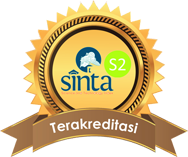Development of Intertextual-Based E-Book on the Concept of Buffer Solution
DOI:
https://doi.org/10.15575/jtk.v7i2.21235Keywords:
buffer solution, interactive, representation, visualizationAbstract
References
Ainsworth, S. (1999). The functions of multiple representations. Computers & education, 33(2-3), 131-152. Retrieved from www.elsevier.com/locate/compedu.
Bozkurt, A., & Bozkaya, M. (2015). Evaluation Criteria for Interactive E-Books for Open and Distance Learning. International Review of Research in Open and Distributed Learning, 16(5), 58–82. Retrieved from https://files.eric.ed.gov/fulltext/EJ1077792.pdf
Brown T. L. LeMay J. H. E. Bursten B. E. Murphy C. J. & Woodward P. (2009). Chemistry: the central science - 12th edition (12th ed.). United State: Pearson Prentice Hall.
Cheng, M., & Gilbert, J. K. (2009). Towards a Better Utilization of Diagrams in Research into the Use of Representative Levels in Chemical Education. In Multiple Representations in Chemical Education, 55–72. Dordrecht: Springer. https://doi.org/10.1007/978-1-4020-8872-8.
Chittleborough, G., & Treagust, D. F. (2007). The Modelling Ability of Non-major Chemistry Students and Their Understanding of The Sub-microscopic Level. Chemistry education research and practice, 8(3), 274-292. https://doi.org/https://doi.org/10.1039/B6RP90035F
Davidowitz, B., & Chittleborough, G. (2009). Linking the Macroscopic and Sub-microscopic Levels: Diagrams. In Multiple Representations in Chemical Education, 169–191. Netherlands Springer. https://doi.org/10.1007/978-1-4020-8872-8_9
Farida, I., Helsy, I., Fitriani, I., & Ramdhani, M. A. (2018). Learning Material of Chemistry in High School Using Multiple Representations. In IOP Conference Series: Materials Science and Engineering (Vol. 288, No. 1, p. 012078). IOP Publishing. Retrieved from http://digilib.uinsgd.ac.id/5760/
Gilbert, J. K. (2008). Visualization: An Emergent Field of Practice and Enquiry in Science Education. In Visualization: Theory and Practice in Science Education (pp. 3–24). Dordrecht: Springer. https://doi.org/10.1007/978-1-4020-5267-5_1
Gkitzia, V., Salta, K., & Tzougraki, C. (2011). Development and Application of Suitable Criteria for The Evaluation of Chemical Representations in School Textbooks. Chemistry Education Research and Practice, 12(1), 5–14. https://doi.org/10.1039/c1rp90003j.
Harrison, A. G., & Treagusf, D. F. (2002). The Particulate Nature of Matter: Challenges in Understanding the Submicroscopic World. In Chemical Education: Towards Research-based Practice (pp. 189–212). Dordrecht: Springer. https://doi.org/10.1007/0-306-47977-X_9
Hidayanti, U., & Rosilawati, I. (2018). Pengembangan E-book Interaktif Berbasis Representasi Kimia pada Materi Larutan Penyangga. Journal Pendidikan Dan Pembelajaran Kimia, 7(2), 1-12. Retrieved http://jurnal.fkip.unila.ac.id/index.php/JPK/article/view/14999
Huda, T. A., Fadiawati, N., & Tania, L. (2015). Pengembangan E-book Interaktif pada Materi Termokimia Berbasis Representasi Kimia. Jurnal Pendidikan dan Pembelajaran Kimia, 4(2), 530-542. Retrieved from http://jurnal.fkip.unila.ac.id/index.php/JPK/article/view/9404
Jaber, L. Z., & BouJaoude, S. (2012). A Macro-Micro-Symbolic Teaching to Promote Relational Understanding of Chemical Reactions. International Journal of Science Education, 34(7), 973–998. https://doi.org/10.1080/09500693.2011.569959
Jespersen, N., Brady, J., & Hyslop, A. (2012). Chemistry The Molecular Nature of Matter. USA: John Willey & Sons, Inc.
Kozma, R.B. (2000). Students Collaborating with Computer Models and Physical Experiments. In C. Hoadley (Ed.), Computer support for collaborative learning. Mahwah, NJ: Erlbaum. https://doi.dx.org/10.22318/cscl1999.439
Kozma, R.B., Chin, E., Russell, J., & Marx, N. (2000). The Roles of Representations and Tools in The Chemistry Laboratory and Their Implications for Chemistry Instruction. Journal of the Learning Sciences, 9(2), 105 - 143. Retrieved https://www.jstor.org/stable/1466853
Kozma, R. B., & Russell, J. (1997). Multimedia and Understanding: Expert and Novice Responses to Different Representations of Chemical Phenomena. Journal of Research in Science Teaching, 34(9), 949–968. Retrieved from https://eric.ed.gov/?id=EJ557519
Lai, J. Y., & Chang, C. Y. (2011). User Attitudes Toward Dedicated E-Book Readers for Reading: The Effects of Convenience, Compatibility and Media Richness. Online Information Review, 35(4), 558–580. https://doi.org/10.1108/14684521111161936
Lynch, K. (2012). E-books: The Future for Publishers and Libraries. Collection Building, 31(2), 78–80. https://doi.org/10.1108/01604951211229872
Munir. (2009). Pembelajaran Jarak Jauh Berbasis Teknologi Informasi dan Komunikasi (TIK). Bandung: Penerbit Alfabeta.
Ohene-Djan, J., & Fernandes, A. A. A. (2003). Personalising Electronic Books. Journal of Digital Information, 3(4). Retrieved from https://journals.tdl.org/jodi/index.php/jodi/article/view/jodi-103
Orgill, M. K., & Sutherland, A. (2008). Undergraduate Chemistry Students’ Perceptions of and Misconceptions about Buffers and Buffer Problems. Chemistry Education Research and Practice, 9(2), 131–143. https://doi.org/10.1039/B806229N
Pallant, A., & Tinker, R. F. (2004). Reasoning With Atomic-Scale Molecular Dynamic Models. Journal of Science Education and Technology, 13(1), 51–66.
https://doi.org/10.1023/B:JOST.0000019638.01800.d0
Silberberg, M. S. (Martin S. (2010). Principles of general chemistry (2nd ed.). USA: McGraw-Hill.
Smith, K. J., & Metz, P. A. (1996). Evaluating student understanding of solution chemistry through microscopic representations. Journal of Chemical Education, 73(3), 233. https://doi.org/10.1021/ED073P233
Stojanovska, M., Petruševski, V. M., & Šoptrajanov, B. (2017). Study of The Use of The Three Levels of Thinking and Representation. Contributions, Section of Natural, Mathematical and Biotechnical Sciences, 35(1).http://dx.doi.org/10.20903/csnmbs.masa.2014.35.1.52
Sugiyono, D. (2013). Metode penelitian pendidikan pendekatan kuantitatif, kualitatif dan R&D. Bandung: Alfabeta.
Sulistyowati, T., & Poedjiastoeti, S. (2013). Kelayakan Multimedia Interaktif Berbasis Intertekstual pada Materi Reaksi Kimia untuk Kelas X SMA. Unesa Journal of Chemical Education, 2(3), 57–63. Retrieved from https://jurnalmahasiswa.unesa.ac.id/index.php/journal-of-chemical-education/article/view/4469
Talanquer, V. (2011). Macro, Submicro, and Symbolic: The Many Faces of The Chemistry “Triplet.†International Journal of Science Education, 33(2), 179–195. https://doi.org/10.1080/09500690903386435
Tan, S., & Waugh, R. (2014). Use of Virtual Reality in Teaching and Learning Molecular Biology. In 3D Immersive and Interactive Learning (pp. 17–43). Springer Singapore. https://doi.org/10.1007/978-981-4021-90-6_2
Tasker, R., & Dalton, R. (2006). Research Into Practice: Visualisation of the Molecular World using Animations. Chemistry Education Research and Practice, 7(2), 141–159. https://doi.org/10.1039/B5RP90020D
Treagust, D. F., Chittleborough, G., & Mamiala, T. L. (2003). The Role of Submicroscopic and Symbolic Representations in Chemical Explanations. International Journal of Science Education, 25(11), 1353–1368. https://doi.org/10.1080/0950069032000070306
Varelas, M., & Pappas, C. C. (2006). Intertextuality in Read-alouds of Integrated Science-literacy Units in Urban Primary Classrooms: Opportunities for The Development of thought and Language. Cognition and Instruction, 24(2), 211–259. https://doi.org/10.1207/s1532690xci2402_2
Vassiliou, M., & Rowley, J. (2008). Progressing the Definition of “E-book.†Library Hi Tech, 26(3), 355–368. https://doi.org/10.1108/07378830810903292
Whitten, K. W., Davis, R. E., Peck, M. L., & Stanley, G. G. (2014). Chemistry (10th ed.). USA: Mary Finch.
Wu, H. K. (2003). Linking the Microscopic View of Chemistry to Real-Life Experiences: Intertextuality in a High-School Science Classroom. Science Education, 87(6), 868–891. https://doi.org/10.1002/sce.10090
Wu, H.-K., Krajcik, J. S., & Soloway, E. (2001). Promoting Understanding of Chemical Representations: Students’ Use of a Visualization Tool in the Classroom. Journal of Research in Science Teaching, 38(7), 821–842. https://doi.org/10.1002/tea.1033
Zhang, D. (2005). Interactive Multimedia-Based E-Learning: A Study of Effectiveness. International Journal of Phytoremediation, 21(1), 149–162. https://doi.org/10.1207/s15389286ajde1903_3
Downloads
Published
How to Cite
Issue
Section
Citation Check
License
Authors who publish with this journal agree to the following terms:
- Authors retain copyright and grant the journal right of first publication with the work simultaneously licensed under a Creative Commons Attribution-ShareAlike that allows others to share the work with an acknowledgement of the work's authorship and initial publication in this journal.
- Authors are able to enter into separate, additional contractual arrangements for the non-exclusive distribution of the journal's published version of the work (e.g., post it to an institutional repository or publish it in a book), with an acknowledgement of its initial publication in this journal.
- Authors are permitted and encouraged to post their work online (e.g., in institutional repositories or on their website) prior to and during the submission process, as it can lead to productive exchanges, as well as earlier and greater citation of published work (See The Effect of Open Access).








